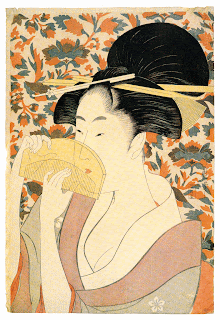 |
| Utamaro, Kitagawa Woman Holding a Comb color woodblock print ca. 1798 Art Institute of Chicago |
Many city-dwellers now had time and money to spend and they had abundant decadent options to choose from. Among these were the lively dramatic kabuki theater performances, the so-called "pleasure quarters" where men could spend time with beautiful and entertaining women, whether sexually or not. In addition, they could take in poetry readings, dance recitals, celebrate festivals, enjoy tea in ceremonies, and eat at the many new restaurants.
Another result of their moving to cities was the loss of the natural world. They came to cherish the beauty of nature in the small, changing details of the cherry blossoms or maple leaves. To retain these natural experiences in their minds, they could buy artists' renderings of these flowers and trees to adorn their walls.
Since their wealth allowed them to travel for pleasure, they could see for themselves the famous and beautiful scenes they had read about in literature. And again, they could buy prints of these landscapes, whether or not they had actually seen them. These provided them a window into the natural world they had left behind.
 |
| Iona Rozeal Brown a3 blackface #58 acrylic/paper 50x38" 2003 |
We, and all the artists after them, are very fortunate to be able to glimpse this world. From the 19th century, when Westerners first saw these Japanese ukiyo-e prints, through today they have inspired many artists from Van Gogh to Iona Rozeal Brown. You can see the work of twelve of these modern day variants in the second part of the show.
Before or after seeing the exhibition you can take a look at our books, both on ukiyo-e prints and on some of the best-known practitioners, like Harunobu, Utamaro, Sharaku, Hokusai and Hiroshige. We also have a new book about Iona Rozeal Brown's recent exhibition of paintings, which she models directly on ukiyo-e prints. She is quite an inspiration herself.
So, go. Divert yourself in just floating, floating... at the MIA
Eva Hyvarinen, Visual Resource Assistant
Minneapolis College of Art and Design
These images were chosen as illustrations for this article and do not represent actual pieces in the exhibition.
No comments:
Post a Comment